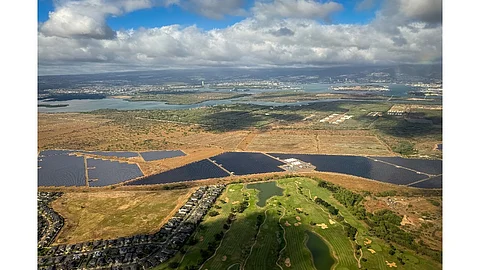

A new study looks at the technical potential that land for golf courses offers for electricity generation through solar and wind parks
Top 10 countries assessed for the same can host between 281 GW and 842 GW of utility-scale PV
The same number of countries can have 174 GW to 659 GW of wind power plants on golf courses
The top 10 countries of the world with the most golf courses carry the technical potential to install up to 842 GW of solar and 659 GW of wind energy capacity in areas equivalent to those currently used for golf courses, according to a new study published in the Environmental Research Communications.
These 10 nations can install between 281 GW and 842 GW of utility-scale PV on 25% to 75% of the golf course land area.
According to the authors of the study, 75% of land coverage for solar is more than the 646 GW of solar power already installed in these 10 countries. Similarly, the top 10 countries can also host between 174 GW and 659 GW of wind power on golf courses.
The study zeroes in on countries with the most golf courses. Out of around 38,400 golf courses located globally in 2024, 80% existed in the top 10 nations studied for the research. Of these, more than 16,000 are located in the US and around 3,100 in the UK. Together, they have allocated far more land to golf courses than to renewable energy facilities.
The number of golf courses is set to increase further in the future as there are more than 500 already planned or under construction in 88 nations around the globe. The US alone is building 124 of these, while Vietnam is getting ready to launch 51 new ones.
They do admit that it will not be feasible to locate solar and wind power plants just about anywhere. It will need careful consideration including distance from distribution and transmission infrastructure that could significantly reduce the potential.
“This study does not advocate that golf courses should be completely replaced, but is intended to provide a proper perspective on how much renewable energy systems could be installed on a comparable area,” state the authors of the study who represent Germany’s Forschungszentrum Jülich, Aachen University, and Karlsruhe Institute for Technology.
Golf courses typically require large amounts of water and chemical treatments, but renewable energy installations such as solar and wind offer a sustainable land use option while lowering GHG emissions. This demands attention to the land use priority, they add, as does the fact that golf courses are accessible only through exclusive memberships, further highlighting land use conflicts.
“Our study does not advocate for the direct conversion of golf courses, but it highlights the vast potential for renewable energy on similarly large and underutilized areas,” explains the Lead Author of the study and Head of the Integrated Scenarios Department at the Institute Jülich Systems Analysis at Forschungszentrum Jülich, Dr. Jann Weinand. “In light of the ongoing debates about land use for renewables, it is crucial to consider how we allocate land overall—especially when significant space is dedicated to activities that benefit only a limited segment of the population.”
Hybrid utilization of golf courses with solar or wind energy plants could be a possible strategy for the future, they suggest.
Titled Countries across the world use more land for golf courses than wind or solar energy, the study is available for a free read here.
